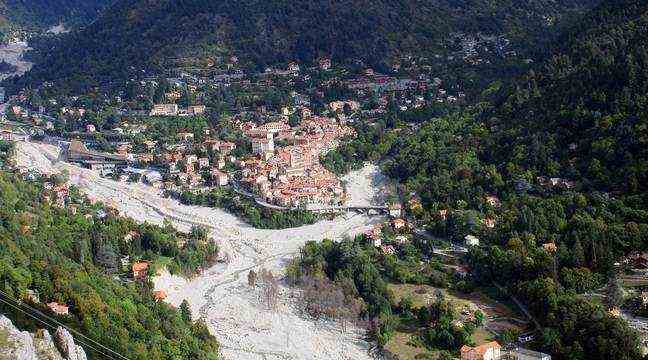On October 2, 2020, the valleys of the Alpes-Maritimes experienced an “extraordinary” phenomenon, as Jean-Christophe Teobaldi, a geographer consultant foresight and inhabitant of Saint-Martin-Vésubie, qualifies. In this village, more than 500 mm of rain fell in the space of 12 hours, “causing water waves of 50 to nearly 100 million cubic meters depending on the watersheds”, specifies climatologist Pierre Carrega in a report. article on the subject. He estimates that the return time for this flood, that is to say, the average duration during which, statistically, an event of the same intensity can reproduce, is 5,000 to 7,000 years.
“If we look at the landscape, apart from the reconstruction priorities,” comments the geographer, “it’s almost the same today as it was after the storm. We can guess at 80% what happened. To the naked eye, it will leave traces for decades. The width of the riverbed alone illustrates this point. “Before, it was a 15 m wide stream. There it is 200 to 300 m. What really devastated the valley and what made it an even more exceptional character was this semi-liquid, semi-solid sediment that spread with such intensity. In addition to these landscape environmental consequences, there is the erosion of the banks with the creation of cliffs, sediments up to 12 m of deposit and the weakening of certain slopes by scouring with significant collapses.
Lessons to be learned for reconstruction
All this information, Jean-Christophe Teobaldi transmitted them just after the storm Alex to the inhabitants so that they can “put words on the phenomenon”. A year later, he shared them with students from the “Environmental hazards and risks management” master’s degree at Imredd Côte d’Azur when they came to the site. For their teacher, Dennis Fox, it was important to allow them to “see the aftermath of such an event.” “They saw the scars of the passage of an exceptional storm in this still affected landscape,” he explains. In addition to seeing the concrete case, they met the inhabitants and further measured the human cost. “
On the academic side but also on the practical side, the students thus observed the vulnerable areas of construction, how a crisis unfolds and how to best prepare the responses to this type of disaster. Axes which they will have to think about for their future because “these are events which will have to happen again”, affirms the professor.
A network of architects ready to intervene
To avoid such damage in the future, certain elements must be foreseen for the reconstruction. The geographer evokes the need to “keep the width of the bed to dissipate the energy of a possible new torrent”, but also “to limit the narrowings which produce disorders upstream and downstream and to enlarge the bridges”. Another track: “move the dwellings that are in the axis of the flow of torrents”.
In terms of housing, the order of architects of the Paca region has also decided to act and anticipate future similar phenomena after the experience of storm Alex. “The week after the events, a group of architects came together to lend a hand to the building unit to take the first survey of buildings still existing and those with pathologies”, develops Arnaud Réaux, vice-president of the order of Paca architects.
He adds: “Our role in this kind of case is to make the diagnoses and the prevention plans. Knowing that we are going to experience similar episodes more frequently, we must be ready to react to this subject. We decided to create, with the Emergency Architects Foundation, a training course so that architects are ready to make diagnoses but also emergency reconstructions and all the elements necessary for life to resume its course for the population. We think of the management of buildings and land, but also of the attitude to have with the victims. “
These bad weather was intensified by many factors, including very dry July and August. According to him, the climate change of recent years is partly responsible. “If it had been a few degrees cooler, it would have snowed at an altitude of 2,000 m, we would not have had the same consequences”. To go further in the analysis and make his observations benefit on a larger scale, he will soon participate in a research group and will work on the valleys of Roya, Vésubie and Tinée to understand more.

